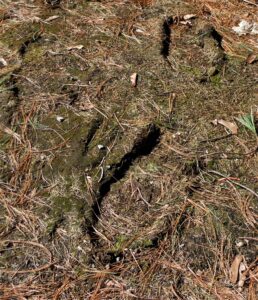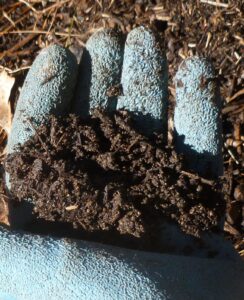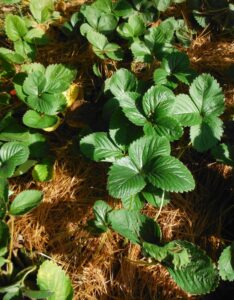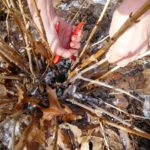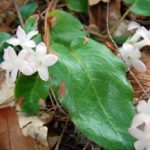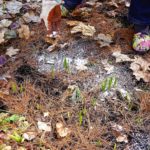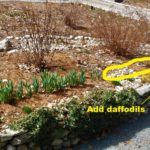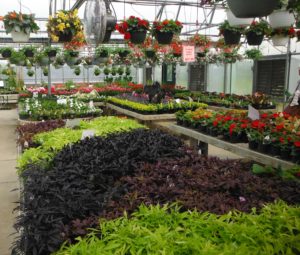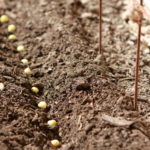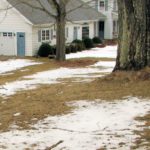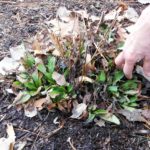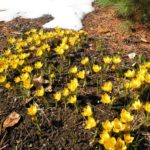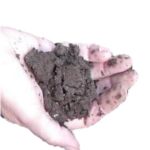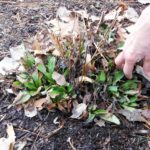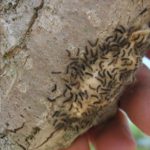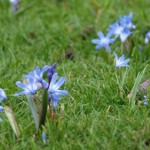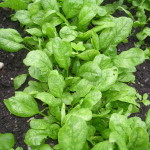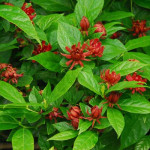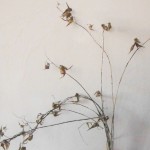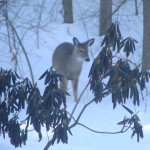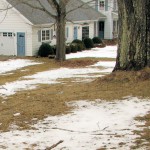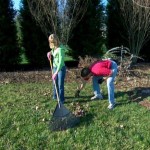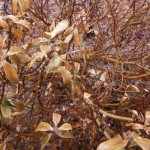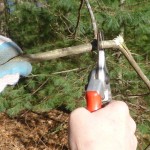Horticultural Hints – April
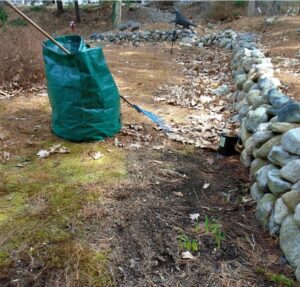 Start the month by removing old mulch, leaves, and evergreen branches from your perennial beds — but stay out of the beds so you don’t compact the soil.
Start the month by removing old mulch, leaves, and evergreen branches from your perennial beds — but stay out of the beds so you don’t compact the soil.
Because the ground is soft, April is a great time to pull out invasive plants such as Japanese barberry (shown here), Japanese honeysuckle and burning bush. Replace these with American natives such as itea (a spring bloomer with fabulous fall color that last longer than burning bush), cornus canadensis (bunchberry — a flowering ground cover with fall berries) and native honeysuckle (lonicera sempervirens).
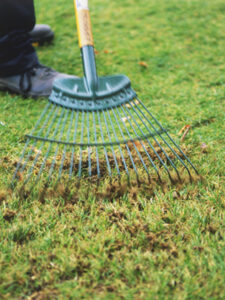 Wake up your lawn by raking with a metal spring rake to remove dead grass and winter debris. Overseed thin or bare areas, and add compost to enrich your soil without the need for chemicals. Consider adding clover to your lawn — it creates a green lawn, doesn’t need fertilizer — it creates its own by fixing nitrogen from the air into the soil. Along with not bagging clippings, you will green up your property and save money.
Wake up your lawn by raking with a metal spring rake to remove dead grass and winter debris. Overseed thin or bare areas, and add compost to enrich your soil without the need for chemicals. Consider adding clover to your lawn — it creates a green lawn, doesn’t need fertilizer — it creates its own by fixing nitrogen from the air into the soil. Along with not bagging clippings, you will green up your property and save money.
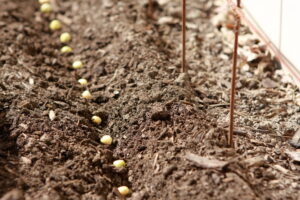 By mid-April — if the soil has dried out sufficiently — you can plant peas, spinach, lettuce, onions, beets and potatoes. (A clump in your hand should fall apart after being squeezed.) Indoors, start your tomato seedlings at the beginning of the month, cucumber and squash late in April. But don’t put them out until the nighttime, not just the day time, temperatures are above 50 degrees.
By mid-April — if the soil has dried out sufficiently — you can plant peas, spinach, lettuce, onions, beets and potatoes. (A clump in your hand should fall apart after being squeezed.) Indoors, start your tomato seedlings at the beginning of the month, cucumber and squash late in April. But don’t put them out until the nighttime, not just the day time, temperatures are above 50 degrees.
Hold off on mulching flower beds until the soil has warmed to at least 55 degrees – likely in mid-May in New England. You may begin mulching around, but never up against, trees and shrubs to prevent mower or trimmer damage to the bark.
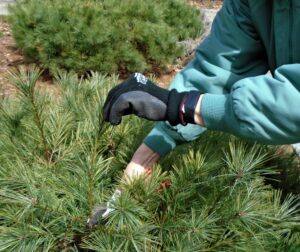 Keep the size of evergreens in check by removing the new growth, called ‘candles’ from ornamental shrubs. Left unchecked, evergreens can outgrow their allotted space and become leggy. Candling evergreens results in denser plants.
Keep the size of evergreens in check by removing the new growth, called ‘candles’ from ornamental shrubs. Left unchecked, evergreens can outgrow their allotted space and become leggy. Candling evergreens results in denser plants.
Beardless (Japanese or Siberian) irises need to be divided regularly. As they grow, the center of the plant weakens or dies. Dig out the clump, cut out 4-to 6-inch segments from the outer ring and discard the center. Plant your renewed irises in soil that has been improved with compost or other organic matter, making certain to keep them at the same depth as they were before.
Enjoy the show from your spring bulbs. Then, photograph and make notes on where to place other bulbs you would like to add to your garden for future years.
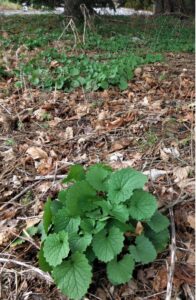 Invasive Alert. Garlic mustard is a very invasive weed that easily out-competes native plants. In early April, garlic mustard pulls easily – roots and all – out of the ground. Be sure to wear gloves because the sap from the plant can cause a painful, poison-ivy-type rash. Once garlic mustard flowers, each plant can produce thousands of seeds that remain viable in the soil for years.
Invasive Alert. Garlic mustard is a very invasive weed that easily out-competes native plants. In early April, garlic mustard pulls easily – roots and all – out of the ground. Be sure to wear gloves because the sap from the plant can cause a painful, poison-ivy-type rash. Once garlic mustard flowers, each plant can produce thousands of seeds that remain viable in the soil for years.
Tread softly. The soil around your home and garden is just coming out of its winter hibernation of alternate freezing and thawing. Right now, the top few inches of soil is exceptionally airy, and every time you walk over it, you compress some of the air out. By the end of April, the soil should be ready for gardening but, for right now, avoid doing damage to your soil by walking on it too much.
Spray dormant oil now to control aphids and other insects on your trees and shrubs. Commercial dormant oil sprays have an emulsifier added to allow the oil to mix with water. Spraying trees and shrubs now, before buds break and leaves appear, will kill eggs and insects while not affecting foliage or harming birds or mammals.
Check before you sow early vegetables. The best test of soil readiness for a home gardener is to take a small handful of soil and squeeze. If it holds together as a wet clump, or heavens forbid, water squeezes out, you need to wait and hope for sunny dry days. Seeds put into cold wet soil will rot. Further, working cold, wet soil with a tiller or spade will destroy the soil structure. When it is ready, plant peas, turnips, spinach, cabbage, lettuce and other cool weather drops.
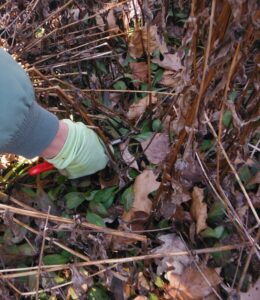 In the flower garden. Any remaining perennial tops from last year should be cut off and removed before new growth begins. A thin top dressing of compost around perennials prior to this year’s bloom will enrich the soil.
In the flower garden. Any remaining perennial tops from last year should be cut off and removed before new growth begins. A thin top dressing of compost around perennials prior to this year’s bloom will enrich the soil.
Resist the temptation to apply mulch now. Applied too early (and April is too early in Massachusetts), the mulch will slow down your garden by acting as a blanket, preventing warming and keeping the soil colder than the air. Later on, those 2 to 3 inches of mulch will keep down weeds and dress your garden.
Strawberries. Start your strawberry bed as soon as the soil can be worked. For new plants, start a new raised bed by creating one at least eight inches deep using a mixture of good soil and aged manure or compost. Because strawberries prefer to grow in a somewhat acidic environment, test the soil for pH and, if it is greater than 6, amend the soil as needed. Create a small mound of soil in the center of a hole. Fan the roots over the mound so they are spread throughout the hole. Be certain the crown of the strawberry is placed so that it is half under the level of the bed and half above when the soil has been firmed in place. This way it will not be likely to rot or be smothered. Water thoroughly and mulch. Heat treated straw or pine needles make an excellent weed free mulch that will also keep the developing berries clean.
What, and what not, to prune. Everyone likes to prune in April, but follow these guidelines: Prune spring blooming trees and shrubs only after the flowers are finished. Don’t be in a hurry to prune off brown areas on evergreens. They often will regrow the needles that have suffered winter kill. A light scratch with your fingernail on the branch will show green if the wood there is still alive. If you have fall-flowering shrubs, this is your last call to prune them.
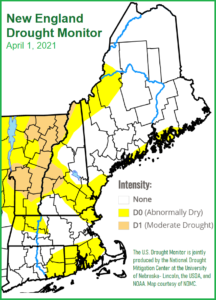 Seasonal forecast. The Drought Monitor issued at the beginning of April shows some danger for New England. Portions of the region are ‘unusually dry’ and Vermont and a small area of New Hampshire is in Stage 1 drought. No area rates ‘severe’ or ‘extreme’. But the same map at the beginning of March showed no drought at all in southern New England. The NOAA’s Climate Prediction Center shows a 50% probability for higher-than-average rainfall for April to June for New England; it also shows a 60% probability of above-average temperatures. Keep these forecasts in mind (and watch for updated ones) as you go through the season.
Seasonal forecast. The Drought Monitor issued at the beginning of April shows some danger for New England. Portions of the region are ‘unusually dry’ and Vermont and a small area of New Hampshire is in Stage 1 drought. No area rates ‘severe’ or ‘extreme’. But the same map at the beginning of March showed no drought at all in southern New England. The NOAA’s Climate Prediction Center shows a 50% probability for higher-than-average rainfall for April to June for New England; it also shows a 60% probability of above-average temperatures. Keep these forecasts in mind (and watch for updated ones) as you go through the season.
Tis is an April unlike any other in memory: the gardening season is beginning, yet the rest of the world, including the usual ‘support systems’ for gardeners (nurseries, garden centers, garden clubs) is largely shut down. Yet, even with seed sources overwhelmed, there has never been more of a demand for gardens – both as a source of food and as a source of comfort in uncertain times.
 If you have nurseries where you usually shop, help them out by buying gift cards now. The nurseries will benefit from the cash flow and you will be greeted warmly when you go in to pick out your plants when they open for business. While many nurseries are open now, not all of them may be following the guidelines on social distancing as much as you might be comfortable with. Call and ask before making the trip!
If you have nurseries where you usually shop, help them out by buying gift cards now. The nurseries will benefit from the cash flow and you will be greeted warmly when you go in to pick out your plants when they open for business. While many nurseries are open now, not all of them may be following the guidelines on social distancing as much as you might be comfortable with. Call and ask before making the trip!
Is it still too cold to garden, or do coronavirus concerns have you stuck inside? Regardless of where you are reading this, watch the videos offered by Grow Native Massachusetts, an organization whose mission is accurately described in its name. For several years they have brought in experts on native plants such as Doug Tallamay, Larry Weaner, Claudia West, and Bill Cullina to speak at the Cambridge Library. Videos from these lectures are available (free!) on their website. Learn in the comfort and safety of your home. And you can always order their books online if you are hungry for more.
It’s easy to keep a safe six feet distance in your yard and garden, so get out there when the weather allows. Clean up your dead leaves, remove dead stalks from perennials that you left up to benefit birds – or because winter got here before you finished the fall clean-up.
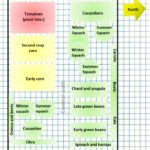 Ready your vegetable garden for spring! Repair any fence issues caused by winter damage. If you haven’t already done so, order seeds by phone or computer (though reports say seed companies are swamped with orders). Lay out your vegetable beds on paper to save time when the soil is ready to plant. This month, you can plant your ‘cold weather’ crops, including spinach, peas and beets.
Ready your vegetable garden for spring! Repair any fence issues caused by winter damage. If you haven’t already done so, order seeds by phone or computer (though reports say seed companies are swamped with orders). Lay out your vegetable beds on paper to save time when the soil is ready to plant. This month, you can plant your ‘cold weather’ crops, including spinach, peas and beets.
Finding very little to admire in the yard right now? Go hunting for some Mayflower plants. aka Trailing Arbutus. It is a low, shrubby plant that blooms early- to mid-spring with pink or white flowers. Each flower is male or female but you’ll need a hand lens to tell them apart. And don’t try to transplant it to your home woods – it doesn’t transplant. That trait is notable because it got the name Mayflower from some of those just off that boat!
Plan additions and alterations to your home garden. Remember what you didn’t love last year? Put some time into finding solutions. Nurseries and their staffs, normally hard to reach at this time of year, are much more likely to be available on the phone or on line right now.
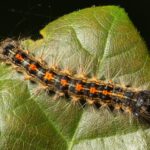 And now for some good news: While we have a lot to worry over this spring, a gypsy moth infestation is not one of them. After a couple of very bad years, the natural cycle is back in balance and gypsy moths will be severely affected by a naturally occurring soil fungus. This fungus kills the moths saving the trees from defoliation and eliminating the need for any application of chemicals by us.
And now for some good news: While we have a lot to worry over this spring, a gypsy moth infestation is not one of them. After a couple of very bad years, the natural cycle is back in balance and gypsy moths will be severely affected by a naturally occurring soil fungus. This fungus kills the moths saving the trees from defoliation and eliminating the need for any application of chemicals by us.
Now’s the time to fertilize all your bulbs. A sprinkling of all-purpose organic fertilizer around bulb foliage now will help them build strength for the future. And, never cut down the foliage (or braid it) before it has yellowed, or you are prematurely removing the food source that builds next year’s flowers.
Plan ahead to next spring. Look around and decide where more bulbs could provide welcome spring color. Then take a photo of the site, mark it up, and store the photo under a title such as ‘Where to plant next fall’. A few minutes now will spare you trying to remember, six months from now, what you wished was there in the spring.
Don’t be seduced by the beautiful displays at garden centers. In Zone 5 or 6, April is too cold to plant any annuals except pansies, peas, spinach and onions. That doesn’t stop the big box stores from putting out festive displays of (greenhouse-grown) plants such as marigolds and impatiens – annuals that require soil temperatures in the 60’s or higher to survive. And favorite vegetables like tomatoes and cucumbers need the soil to be over 70˚ before you think of planting them outside. Spend a few minutes online getting information from reliable sources, not from the guy at a store who may have been in charge of light bulbs last week. You’ll save yourself time, money, heartbreak and effort.
Plant cold hardy crops early this month. Put in your radishes, peas, carrots, beets, spinach, onions as soon as the garden is dry enough not to leave footprints. Use row covers to help warm the soil and exclude insects that will attack your plants.
Save time and money by skipping early spring green-up routines promoted by fertilizer companies. Lawns (which are perennial, meaning they come back every year) should be fertilized in the fall when it will build stronger roots, and when weeds (which are annuals) are dying. Fertilizing now will cause your lawn to green up in just a few weeks… but it also gives a head start to the weeds. All your lawn really needs now is a good raking with a spring tine (metal) rake to remove winter debris. It will green up just fine on its own.
Celebrate Earth Day on April 22nd. After a winter not soon to be forgotten, make an effort to do something to help Mother Earth overcome the many, many problems we humans have thrown at her. Help clean up the banks of a stream or a beach that ‘somehow’ collects trash. Get together a group of friends (including younger members of the community) to find and pull, cut down (or dig out as appropriate) invasive plants that have taken over from native plants. And plant a group of Massachusetts natives on your property—or on public property (with permission) to provide the food needed by native birds, bees and butterflies. Not sure where to find them or what to plant? The Grow Native Massachusetts
provides a resource list and ample information you will need.
Celebrate Arbor Day on April 27. Trees are a wonderful part of our environment. If you plant natives, you get more than shade. Native oaks are a vital food source for over 500 varieties of caterpillars that grow up to be the colorful butterflies and moths that pollinate flowers, provide food for birds and enhance our lives. Native maples feed nearly 300 varieties. But too many of the trees we plant originated in other parts of the world and cannot help our environment to stay healthy. Plant for shade and flowers–native dogwood (Cornus florida) will delight you with flowers in the spring and a tree that appears to have developed the ‘shakes’ in the fall as dozens of birds stop to eat their large berries to fatten up for winter or load up before migrating south
Remove winter protection such as evergreen boughs and mulch or dirt piled around the base of tender plants. But stay off wet beds! Use a long-handled rake if need be to get at plants that need uncovering but are surrounded by ‘impressionable’ soil.
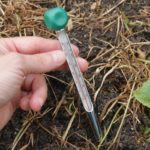 Hold off applying mulch until the soil has warmed to at least 55˚ — a soil thermometer is a great investment for any gardener. Covering the soil earlier will hold the cold in, slowing down the new growth of your plants. And think about skipping mulch altogether—it’s actually not good for the garden— and planting ground covers: ferns or tiarellas in the shade, thyme or carex in the sun. They don’t need to be mown or replaced annually, and look better than chipped wood!
Hold off applying mulch until the soil has warmed to at least 55˚ — a soil thermometer is a great investment for any gardener. Covering the soil earlier will hold the cold in, slowing down the new growth of your plants. And think about skipping mulch altogether—it’s actually not good for the garden— and planting ground covers: ferns or tiarellas in the shade, thyme or carex in the sun. They don’t need to be mown or replaced annually, and look better than chipped wood!
Enjoy spring bulbs. Bulbs are ideal for the low-maintenance garden: you put them in once and watch them take care of themselves for years (or decades) thereafter. Make note of areas where you can add more bulbs in the fall for next spring. Include in your notes the colors you think will look best and make certain to get the names of bulbs you admire but can’t immediately identify.
Never work or walk on wet soil. Having been kept at bay since November, we’re all anxious to get started in our gardens. However, wet soil will compact into an airless mass that won’t grow much of anything, and the much-needed rains and/or wet snow that fell at the end of March and beginning of April pretty much ensure that the top several inches of your soil is waterlogged. Pull up a handful every few days and test it. Only when the soil crumbles in your hand like a piece of cake is it ready to be worked. That same advice goes for your lawn.
It’s always chancy in April, but you can start seeding some vegetables and flowers. Peas, radishes, leaf lettuce, spinach and onion sets can go into the garden as soon as the soil is dry enough. Floating row covers placed over the planted area will give you a couple of extra degrees of protection on cold nights. My spinach (in a raised bed) survived the winter and is now growing vigorously on its year-old roots.
If you grow your own warm weather seedlings, tomatoes, squash, eggplant, peppers and so forth, now is the right time to start them. It takes them eight or more weeks to be ready to plant out and June will be here soon.
Mulch do’s and don’ts. Pull back mulch anywhere green is showing on perennials, including strawberries and bulbs. But be prepared to add some cover if night time temperatures drop in the twenties. Conversely, never put fertilizer on top of mulch unless you want to help any weed seeds that may have fallen there. Place any fertilizer on the soil after you have pulled the mulch back.
Before you put down fresh mulch, remember the two-inch rule: if the mulch is deeper than your forefinger, it will prevent water and air from reaching the roots of the plants that you want to benefit. And colored mulches (red and black, for example) may be colored to disguise the use of recycled wood from industry. Steer clear of them.
Soil Test. The soil should be diggable to 6 or 8 inches so now is the time to send off a soil sample for testing to your state’s testing agency. In Massachusetts, send in your soil test to UMass. In other state, county extension services or the Ag school of your state university likely offers comprehensive tests at very reasonable rates. Labs will soon be busy and you want to get your results quickly so you can add whatever amendments are needed. You’re certain to save time, money and energy by not putting down products that are not needed.
How to be nice to your lawn. First, keep off the lawn until you know it is no longer soggy. New England lawns should not be fertilized in the spring. Grass roots growth in the fall. If you fertilize now, all you’ll do is feed your weeds. As to weed control, keep in mind that ‘weed-and-feed’ and ‘weed-plus-insect-control’ products kill not only weeds, but also beneficial insects and the micro-organisms that make up healthy soil.
Caterpillars on your trees? They can be tent, gypsy moth or winter moth caterpillars which can all be treated with environmentally friendly Bacillus thuringiensis K (BT-K), available at local nurseries. But even with this, please use it carefully and read the application information. Look for the caterpillars before you spray, spray early in the day when there is little wind and, most importantly, remember that not every caterpillar is a pest. The birds need hundreds of caterpillars to raise each of their young. Young birds cannot eat seed or hard shelled insects. They need soft sources of protein.
Arbor Day & Earth Day. April is the month to think about our Earth. Planting a tree, particularly a native tree, is an investment in summer shade, fruit, a better view, or a place for birds to live (and eat). A tree will grow to be ‘home’ for a game of It. It can anchor a bed of flowers, provide great autumn color, or a million other things. Don’t have room to plant a tree? Donate one to a town or a school. Or plant a shrub or flowers or vegetables. But most of all think about how we can protect and enhance our Earth.
Beautiful Bulbs. Spring bulbs are up on or ahead of schedule this year. The bulbs in your garden bloom using the energy they built up the previous year so, to ensure a colorful 2017, use a rainy day this month to put down an organic fertilizer (unless the ground is squishy) to feed the bulb’s roots for next year. Never cut down or braid daffodil foliage. Daffodil greens send down food to the bulb until mid-summer, when the foliage turns yellow and die naturally. Do you hate the sight of the yellowing foliage? Plant perennials around the bulbs. Perennials come up later and hide the dying foliage naturally. If you have bulbs (such as Chionodoxa) naturalized in your lawn, give them a month after blooming before mowing. The grass will also appreciate the extra time to put energy into the roots after the winter.
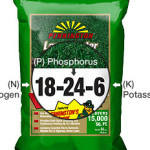
Phosporous is the middle number in bags of fertilizer. Massachusetts law forbids the use of phosporous on lawns unless a soil test shows a need.
Fertilizing Your Yard? Before you run out to buy lawn or garden fertilizer this year, (or your lawn service arrives) be certain you are aware of the regulations regarding applying phosphorous to any area of your yard. Last summer the Massachusetts legislature followed other states in requiring that no phosphorous can be applied to an area unless there is a soil test proving the area is deficient in phosphorous. The test must be done by the UMass soil testing lab (soiltest.umass.edu) or one using UMass approved procedures. Home test kits are not valid for this purpose. Regular soil tests are an easy and inexpensive (compared with fertilizing) way to know what your lawn and garden really needs.
Soil in this area is seldom low in phosphorous so chances are you do not need it. The reason for the law is that phosphorous runoff is a major cause of pollution of streams, rivers, lakes and the ocean. Just because your property doesn’t overlook water doesn’t mean that it is not a problem. Nutrient runoff leads to algae blooms, dead areas in the ocean, lakes and ponds, and an increase in ozone caused by the increase nitrogen oxides in the air. Save money and leave the nitrogen fertilizer in the stores. An easy-to-understand fact sheet is available at http://www.mass.gov/eea/docs/agr/pesticides/docs/plant-nutrient-regs-turf-and-lawns-factsheet.pdf
In the Vegetable Garden. Our area is getting an earlier start this year than in the recent past. My garden is already showing some spinach seedlings, and the peas should be up any day. Unless we get a real cold snap, you can put in the early salad greens and most oriental greens now. If there’s a cold night, cover your vegetables with floating row cover or an old sheet in the late afternoon — and remember to remove the cover as the day warms. By mid-month you can add beet, radishes, turnips, kale and cabbage.
If you start your own tomatoes, cucumbers, basil or melons indoors, do so now. Remember they need light, warmth, and good air circulation to flourish. Many seedlings succumb to fungal diseases because of excessive watering or an environment that encourages fungal growth.
Around the yard. Continue to stay off soggy soils but, as it firms up, remove any winter debris from garden beds and lawns. Seed heads left up for the birds need to come down before the new growth begins.
If you already have plans for new plantings, head to the nurseries while the inventory is high. Now is a great time to start putting in woody plants—trees and shrubs will have a chance to start establishing their roots before the heat of summer makes the work harder for your new plant’s reduced root system. As it is Earth Day this month, think native trees and shrubs. Consider an Oxydendron, a beautiful tree with a graceful shape for your front lawn that blooms in July-August and puts on magnificent colors in the fall. Put in a calycanthus (also called a sweetshrub) that offers some of the best fragrance from any shrub I know. Calycanthus will give pleasure all summer if you go with the less showy but nonstop-blooming native species. Give your new shrubs a good start and loving care for several years and they will last a lifetime.
Swallowwort watch. Until just a few years ago, black swallowwort was virtually unknown in Massachusetts. It has now become an endemic, nasty invasive plant, usually inhabiting the border between streets or lawns and surrounding woods. More than just an invasive nuisance, swallowwort endangers the Monarch butterfly. Because swallowwort mimics milkweed, Monarch females lay their eggs on swallowwort leaves, which offer no nutritional value to caterpillars. Thus, swallowwort may act as a “sink” for Monarchs; caterpillars from eggs laid on these invasive plants will not survive, and are essentially wasted.
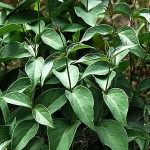 In April, you can still see the husks and skeletons of last year’s plants. Mentally or physically mark the area and, as soon as this year’s vines emerge, rip out or dig out plants and their roots. Make certain you bag and send the plants to your town’s transfer station. Composting swallowwort allows it to regenerate and re-root.
In April, you can still see the husks and skeletons of last year’s plants. Mentally or physically mark the area and, as soon as this year’s vines emerge, rip out or dig out plants and their roots. Make certain you bag and send the plants to your town’s transfer station. Composting swallowwort allows it to regenerate and re-root.
Another month and the snow is melting—but not fast enough. As anxious as you are to get out there and get going, try to be patient. I look out on the broken branches of several evergreens and (thanks to deer and rabbits) the chewed-down tips of everything from viburnum and hydrangeas to leucothue and redbud trees.
My first inclination is to start pruning back these branches to help them recover, but stay off the lawn and garden beds until they have dried somewhat. When you can walk on the soil without leaving footprints, you can prune those broken and devoured shrubs and trees back to healthy wood. If you have any doubt about whether a branch is dead, give it more time and if you want good advice on how to prune, try The American Horticultural Society’s Pruning.
The lawn has also had a hard winter. December’s extreme cold came before there was any snow cover, placing a lot of stress on all plant roots. The grass has been now covered for nearly three months. When it emerges, give it a chance to get acclimated – think how the sun blinds you after being indoors on a summer day.
Do not feed the lawn for two to three weeks after it reappears. When it is firm enough to walk on and before fertilizing, go over it with a spring rake, collecting the twigs, errant leaves and other winter debris while lifting the grass blades. The best thing you can do is put a quarter to half inch of compost over the lawn and allow Mother Nature to do the work. Healthy lawns have billions of fungi, bacteria, and other microscopic organisms that help breakdown food so it can be used by the roots and keep many of the bad bugs at bay.
If you must feed it, use an organic fertilizer. It reacts more slowly than chemical fertilizers but lasts much longer. The traditional multi-step programs used by many homeowners put your lawn on an IV of intensive feedings. Instead of strengthening the grass, these programs make your lawn dependent on frequent infusions of chemicals. Stepping away from the widely advertised programs can be difficult, but will give you and your family a healthier lawn that stands up better to the stress of summer heat and our miserable winters.
Spring Bulbs. The late spring this year may mean snowdrops, tulips, crocus, daffodils and hyacinths will all be up at the same time. Make note of ‘bare’ areas that could use early color. One way to keep track so you can find the spots when it’s time to plant in September and October is to mark them with brightly colored golf tees—small enough not to be intrusive, but easy to see when you are looking for them. Non-hardy summer bulbs such as dahlias, cannas and tuberous begonias should be started indoor now.
Vegetable gardens. “Plant your peas on St. Pats Day.” Hah! Don’t start before the soil is ready. When the soil in your gardens crumbles in your hand it is ready to be worked — and not before. The late start will not mean significantly later crops because the warmer soil, the longer days and stronger sun will make the plants grow faster.
If you have raised beds, you can probably start planting as soon as the snow has melted off because the raised-beds are designed to provide great drainage. Stick with cold weather crops at first—peas, spinach, lettuce and members of the cole family such as kale, broccoli and cabbage. While some hardy crops can take cold soil and air temperatures, don’t fall for the lure of planting beans, beets or carrots until the soil temperature reaches 60 degrees. Your seeds will just rot in the ground.
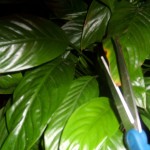
Houseplants that have been dormant for the winter need to be brought back, including cutting back diseased leaves
Indoors. When the rain or cold keep you inside, use the time to groom and feed your houseplants. They should be receiving regular weak feedings of a liquid plant food ( or a sprinkling of slow release pellets) to help them shake off the winter doldrums. If your plants look leggy or have damaged leaves, now is a good time to prune them back. You can also replant anyone who did not get a new home last year. Soil in a pot wears out and if you want the plants to look good, give them what they need.
It’s raining, it’s pouring outside my window as this is written. With the ground already soggy from melting snow, it may be many days before you can safely walk on lawns or garden beds. Walking across soggy ground compacts the soil and may damage plant roots, so don’t do it. Wait to begin any work until lawns are solid underfoot and flower or vegetable garden soil crumbles (like chocolate cake) when gently squeezed in your hand.
When you can get around the lawn without damaging the soil, don’t fertilize! Your grass is a perennial, most weeds are annuals, so fertilizing now gives the weeds a good start. The time to fertilize is in the fall when the weeds are not growing and the grass will build up strength for the following year. In fact, many weeds will begin growing while the grass is still dormant. That makes it easy to pull or dig then out now when they stand out against the lawn.
If your lawn did not look good last year, get a soil test and find out what it really needs. No matter what the ads say, adding fertilizer, herbicides and pesticides to the lawn is not the way to a healthy, green lawn. Consider overseeding a thin lawn later this month.
When your lawn is no longer soggy, it will need a good raking with a spring rake (the kind with flexible tines) to remove the winter accumulation of small branches, leaves that have blown in, and the dead grass or weeds that come up easily. This raking also serves to also stand up the grass matted down by snow cover, telling it spring has arrived.
As they break ground, put a small circle of organic fertilizer (or a thicker circle of compost) around your spring bulbs and perennials. Fertilizing them this month will feed them this summer and help ensure another bright spring next year.
Prune back fall blooming hydrangeas and clematis, butterfly bush and roses. Prune forsythia as soon as they finish blooming.
Don’t be too quick to prune off browned branches on evergreens. Give them time: they may recover and green up again. Any broken or damaged branches should be removed as soon as possible. Look for rodent damage on trees and shrubs. Hidden by the snow and looking for food, they may have gnawed off bark and even into the living tissue of the tree. A few bites won’t seriously injure a tree or bush, but if it has been girdled half or more of the way around, it may not survive. Put a reminder in your calendar for November to put tree guards around the bottom two to three feet of young trees. Or, spray trees and shrubs monthly throughout the winter with deer and rabbit repellents.
On a day when the temperatures will be above 40 degrees for several hours, spray fruit trees, hollies and arborvitae with horticultural oil which smothers the eggs of many pest insects.
Vegetable gardens also need to dry out before you begin planting. This is one advantage of raised beds that dry out and warm up faster in the spring than do conventional gardens. As soon as the soil is dry and workable, it will be time to get in the peas, spinach, lettuce, kale, cabbage and many oriental greens. Toward the end of the month, plant beets, carrots, parsnips, potatoes and swiss chard.
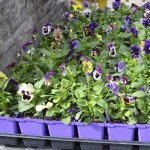
Pansies are tough and can take early April weather. Don’t plant anything that can be killed or stunted by below-freezing weather until that danger is past.
Annuals at the nurseries may look appealing, but use common sense. With the exception of some cold-hardy plants like pansies and osteospermum, leave them behind. We will still have more than a few freezing night. No matter how wonderful it would be to have petunias and geraniums and marigolds, or get a head start with tomatoes, save your money and leave them on the nursery tables until the danger of frost has passed.
It is, however, a great time to plant many trees and shrubs, giving them a chance to begin establishing their roots before the hot weather of summer strikes. Take a look at any notes you made last year, and get to those nurseries to purchase the plants you want or need to add more beauty to your property.
Snow, snow go away! The snowstorms didn’t start until February and, if they would just stop, we could begin our spring gardening. Stay off wet lawns and gardens! You will compact the soil and make it a much less hospitable environment for the grass or plants you want to grow there. After all the snow has melted and the soil has dried enough that it no longer stays in a tight clump after being squeezed in your hand , it’s ready to work.
Pick debris off the lawn. Once your lawn has dried, give it a good going over with a metal spring rake. This removes the small debris and lifts the grass compacted by the snow. Do not fertilize the lawn now. It is weak from winter and force feeding it a high nitrogen diet will not strengthen the plants.
Prune away any damage from our winter storms. Remember any pruning done on spring bloomers will reduce the number of flowers. But it is always important to take off branches that have been torn (and still hanging on) or are broken leaving a ragged end. While you are at it, remove any crossing or rubbing branches in the interior of the tree. If you have deer damage, consider using one of the sprays that are applied monthly and cause the foliage to have a foul taste. The deer will be on the prowl for food now that the snow is gone.
Clean your beds. If you left last year’s perennials for the birds, remove the old stems now. Even if you cleaned the bed last fall, rake it now to remove the material that has blown in over the winter. Be careful not to tear the foliage of bulbs or early perennials.
Start your vegetables. If your garden soil has dried enough to pass the clump test, start planting. Peas, spinach, lettuce, onions, kale and other cold-hardy types can go into the ground now. Indoors, if you have light and space, you can start some of the hot crop vegetables—tomatoes, peppers, eggplant as well as herbs and many flowers. The correct starting date is determined by the planting date and how many weeks the package (or catalog) tells you it will take to get to transplant size. Starting too early means leggy and spindly plants that won’t do well in the garden. The average last frost date for this area is Memorial Day. Experience has taught me to wait for June 1. If you live in Boston, it’s earlier, if you live west or north, it may be later.
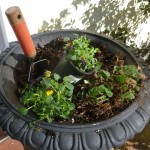
Pansies can take a cold New England April, but avoid putting out tender annuals like marigolds and petunias.
Visiting Nurseries. Can’t wait to see plants at the nurseries in the spring? Contain your enthusiasm. Just as clothing retailers are showing bathing suits, some plant retailers tend to ‘push’ the season prematurely. You can plant pansies and the cool weather vegetables in April, but there is no sense in buying tomato seedlings, marigolds and petunias yet. At best they will be stunted by the cold weather; at worst, they shrivel and die during a frost. It’s a great time to buy trees and shrubs which do well during the spring. Planted early, they begin growing roots before the hot weather puts additional strains on them.
Hot weather in Spring. Mid-March’s sunshine and abnormally warm weather likely drew you outside and tempted you to advance your gardening plans, but be very careful what you do now in the garden (as demonstrated by those nighttime temperatures in the teens just a few days later). If you mulched around plants for the winter, or covered them with cut up branches, those can be removed now. Begin raking leaves off the bed before the bulbs and perennials springing up become an impediment to that chore. Keep in mind that this is New England, where heavy snowfalls have shown us the meaning of April Fool’s Day and, just a few years ago, two inches of slush destroyed all the flowers in late May.
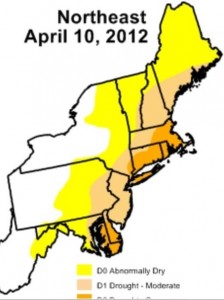 Spring Drought! One reason you’re able to do all this outdoor work is because the ground is very dry. We had virtually no snow this winter. In a normal year it would have slowly melted into the ground, watering the trees and shrubs and refilling reservoirs. With a dry spring so far, we could be in trouble. Rhododendron bushes in my yard were drooping last week and received a long slow watering to ensure blooms in May. Other plants may not show signs of trouble or have problems yet, but the light showers we had at the end of March are insufficient. We need good, long, soaking rains and, unless April showers harass us throughout the month, we may be facing a very tough summer in the garden. [This map is current to April 12].
Spring Drought! One reason you’re able to do all this outdoor work is because the ground is very dry. We had virtually no snow this winter. In a normal year it would have slowly melted into the ground, watering the trees and shrubs and refilling reservoirs. With a dry spring so far, we could be in trouble. Rhododendron bushes in my yard were drooping last week and received a long slow watering to ensure blooms in May. Other plants may not show signs of trouble or have problems yet, but the light showers we had at the end of March are insufficient. We need good, long, soaking rains and, unless April showers harass us throughout the month, we may be facing a very tough summer in the garden. [This map is current to April 12].
Start your vegetable garden. With the soil dry enough to work, get going on the vegetable garden now. Put up or repair fences and raised beds, add a top dressing of compost and, if you haven’t already, get your seed order in! Plant your first crop of peas and lettuce, radishes and beets and spinach and parsnips as soon as you are able. They can take a few cool nights without harm, and row covers can provide a few extra degrees of protection when necessary. If you start your own warm season crops indoors, plant tomatoes and peppers, basil and melons indoors now so they are ready to set out on or about Memorial Day.
Planting the landscape. It’s an excellent time to plant new shrubs or trees, before they have leafed out. Bare rooted plants also do best going into the garden now. Beware of plants in nurseries, some, such as pansies and osteospermum may be able to survive light freezes, but chain stores are already starting to offer up annuals that cannot tolerate cold New England nights. Curb your enthusiasm and save your money for later in the season.
Lawns. Use a spring rake to remove winter debris from the lawn. Leaves, small branches and any dead plant matter can be put into your compost bin. The raking will lift and awaken the grass. But you shouldn’t fertilize now. Despite what you see in advertisements, fertilizer will feed the weeds that grow more quickly and vigorously than grass. New lawns should have been started in the fall when weeds are at a disadvantage because the days are growing shorter. A thin layer of compost (a quarter to half an inch) spread over the lawn is all the nourishment your lawn needs for the summer.
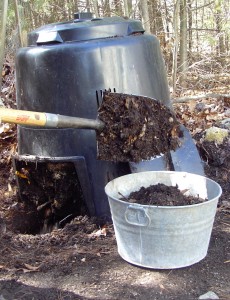 Compost Harvest. The leaves you raked off the beds and lawn belong in your compost bin. Turn the bins that have been sitting all winter, remove the finished compost, add the leaves and any” unfinished” compost. (If it still looks like plant material, it’s unfinished.) Finished compost can be spread over the lawn, used to mulch beds once the plants growing there are up or saved to amend soil while planting.
Compost Harvest. The leaves you raked off the beds and lawn belong in your compost bin. Turn the bins that have been sitting all winter, remove the finished compost, add the leaves and any” unfinished” compost. (If it still looks like plant material, it’s unfinished.) Finished compost can be spread over the lawn, used to mulch beds once the plants growing there are up or saved to amend soil while planting.
April 2011
If you need to prune any spring bloomers either because of winter damage, or for better shape, do it now, but save the branches to force indoors. Finish cleaning up downed branches from winter storms, making certain to leave a clean cut behind. If the tree is too large for you to reach the damaged areas easily, call in an experienced arborist—ladders and chainsaws are a very dangerous combination.
Every vegetable gardener is anxious to get started. Sowing seed of hot weather crops such as tomatoes, peppers and melons indoors is fine, but don’t start planting outdoors until the garden has dried out from the spring rains and the soil (not air) temperature has reached 40 degrees.
This spring, Mass Hort will be building and planting a series of garden beds based on national and regional cuisines. They are also planting a garden specifically to supply a local food bank. To go along with these new gardens, they will be offering lectures and demonstrations to help the novice get started and showcase new plants and techniques for all gardeners.
Save your self some time and money and be kind to the environment by skipping the ‘early spring green-up’ lawn fertilizing recommended by fertilizer sellers and lawn companies. In New England all you need at this time of year is a thorough raking with a metal spring rake Congratulations to those who used the dry days of March to rake off lawns and begin cleaning beds. If you are just getting started cleaning your lawn, stay off it to preventing compacting the soil until after it has dried from the most recent rain and snow.
When the temperature is above 40 degrees, and promised to stay there for a few hours, apply dormant oil spray to woody shrubs and trees affected by scale, other sucking insects and reduce the damage by winter moths. Remember it must be used before the leaves emerge.
When you prune hydrangeas is a puzzle to many home owners. If the hydrangea bloomed in late summer last year, prune back all dead flowers and any dead or broken wood now. Because these hydrangeas bloom on new wood, renewing the bush by removing up to a third of the old stems will increase its vigor.
If the hydrangea bloomed in late spring or early summer, you need to wait until after it blooms to prune it or you will be removing this year’s flowers because it blooms on old wood. If you notice fewer blooms this year, it could be the result of the extreme cold and harsh winds suffered during the winter.
Finally, the newest hydrangeas are referred to as everblooming because they have the ability to bloom on both old and new wood. Removing up to a third of the branches (choosing those that are the oldest) will keep the shrub blooming at its best throughout the year.
April 2010
Start the month by removing old mulch and evergreen branches from your perennial beds—but stay out of the beds so you don’t compact the soil.
April is a great time to pull out invasive plants such as Japanese barberry, Japanese honeysuckle and burning bush while the ground is soft. Replace these with American natives such as itea (a spring bloomer with fabulous fall color that last longer than burning bush), cornus canadensis (bunchberry — a flowering ground cover with fall berries) and native honeysuckle (lonicera sempervirens).
By mid April—if the soil has dried out sufficiently—you can plant peas, spinach, lettuce, onions, beets and potatoes. Indoor, start your tomato seedlings at the beginning of the month, cucumber and squash late in April.
Wake up your lawn by raking with a metal spring rake. This will remove dead grass and winter debris. Overseed thin or bare areas. Consider adding clover to your lawn—it creates a providing natural fertilizer by fixing nitrogen in the soil.
Hold off on mulching flower beds until the soil has warmed up. You may begin mulching around, but never up against, trees and shrubs to prevent mower or trimmer damage to the bark.
Beardless (Japanese or Siberian) irises need to be divided regularly. As they grow, the center of the plant weakens or dies. Dig out the clump, cut out 4 to 6 inch segments from the outer ring and discard the center. Plant your renewed irises in soil that has been improved with compost or other organic matter, making certain to keep them at the same depth as they were before.
Enjoy the show from your spring bulbs.
April 2009
Give soggy lawns and gardens a chance to dry out before you begin working them. Walking on them now will compact the soil and make the roots of your plants work much harder throughout the growing season. When your lawn has dried (wait until you’ve had 4-5 days of sunny weather), remove any winter debris by raking lawns with a spring tined rake rather than a rigid, plastic one. Fertilizing and seeding are best done in the fall. New England lawns do well without a spring fertilization, but a thin (1/4 inch) topdressing with compost will do wonders for it.
With the warmer temperatures, winter moth caterpillars are hatching. As they begin their climb to the swollen leaf buds they are at their most vulnerable. Now is the time for your arborist to spray trees such as oaks, maples, birches and apples. Winter moths can only be attacked before they hide in the leaf buds or after the leaf buds unfurl, when the first round of damage has already occurred. Winter moths will then move on to other plants, including blueberries and roses.
In the gardens, any remaining perennial tops from last year should be cut off and removed before new growth begins. Perennials and bulbs can be fertilized with a small amount of fertilizer applied around—not on—the plants. A thin top dressing of compost will enrich the soil, but resist the temptation to apply mulch now. Later on (say, in May), those 2 to 3 inches of mulch will keep down weeds and dress up your garden. Right now, all the mulch will do is slow down your garden now acting as a blanket to keep the cold in the soil.
Last call to prune fall flowering shrubs. Prune spring blooming trees and shrubs after the flowers are finished. Wait to prune off brown areas on evergreens. They often will replace the needles that have suffered winter kill without pruning. A light scratch with your fingernail on the branch will show green if the wood is still alive.
Ready, set, SOW—It’s time for those who grow their own to start seeds of the hot weather crops such as tomatoes and peppers. If you don’t have grow lights, place seed trays in south facing windows. A little extra heat, especially from the bottom of the container will speed germination and growth. Do not allow the soil to dry out. Thin crowded seedlings so the remainder will grow stronger and healthier. When the soil dries out enough to be workable—that is when it crumbles after being squeezed in your hand—you can plant peas, radishes, beets, spinach and lettuce. These cool weather crops can withstand some cold nights as long as the soil isn’t soggy and they get daytime sun.
Now is a good time to plant trees and shrubs. Remember to think ‘saucer’ instead of teacup when digging. The hole should be no deeper than the root ball and three times as wide. When the tree or shrub is planted, the soil should be at the same level on the trunk as it was before.
Don’t be tempted by buying annuals yet. They’re already flooding the markets but few beyond pansies are likely to survive the cold weather we in New England will see in April. Favorites such as geraniums and tomato seedlings will be stunted or killed by the chilly nights still to come. There will still be plenty of choices when it’s truly annual planting time in New England, and that’s not until mid to late May.
